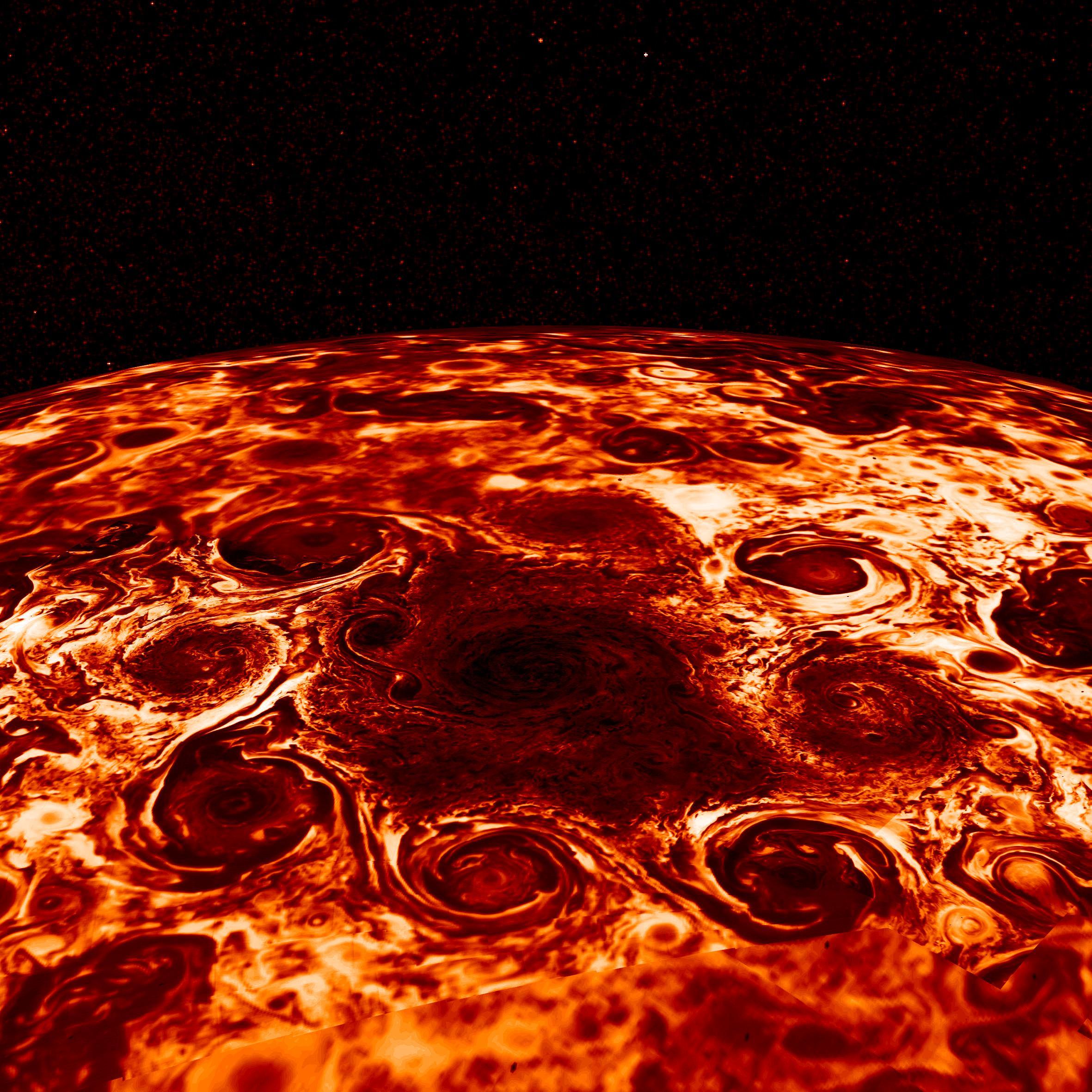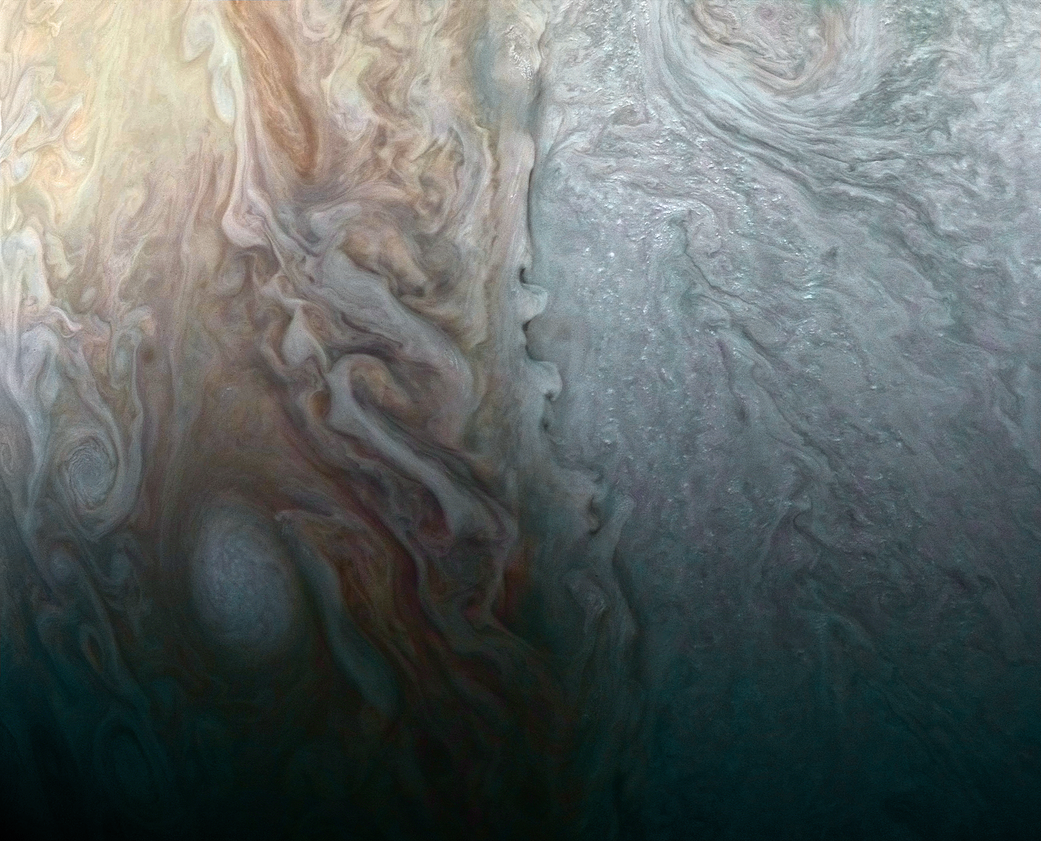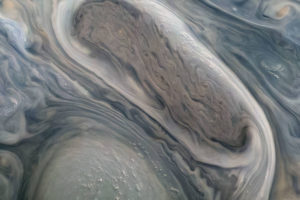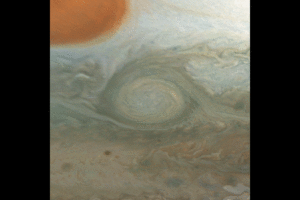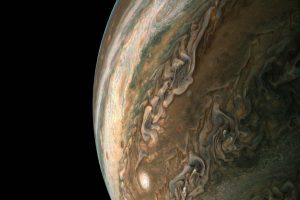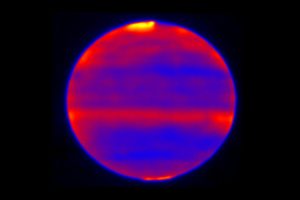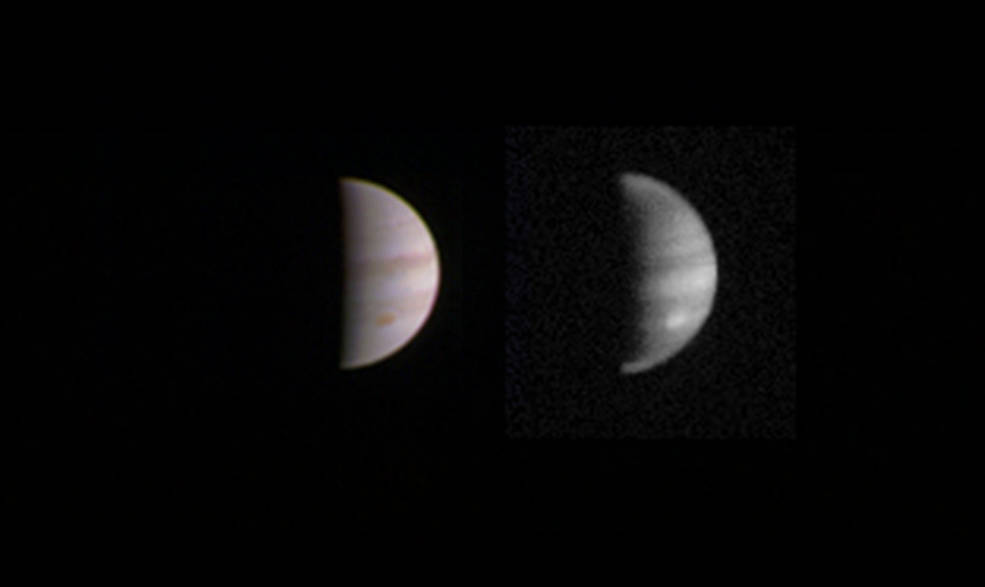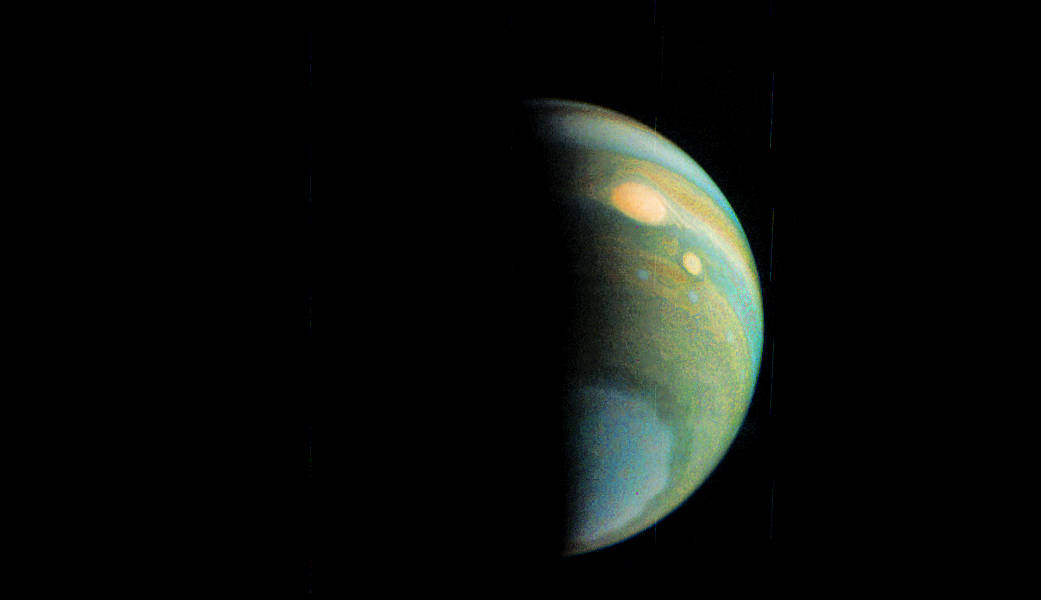Composite image, derived from data collected by the Jovian Infrared Auroral Mapper (JIRAM) instrument
This composite image, derived from data collected by the Jovian Infrared Auroral Mapper (JIRAM) instrument aboard NASA’s Juno mission to Jupiter, shows the central cyclone at the planet’s north pole and the eight cyclones that encircle it.
Credits: NASA/JPL-Caltech/SwRI/ASI/INAF/JIRAM
木星オーロラ観測用赤外線測定器(JIRAM)によって観測・収集したデータから作成した画像です。
JIRAMはNASAの木星探査機に搭載されt観測装置で、木星の北極中央にあるサイクロンとそれを囲む8つのサイクロンをとらえた画像です。
オリジナル記事
NASA Juno Findings – Jupiter’s Jet-Streams Are Unearthly
Data collected by NASA’s Juno mission to Jupiter indicate that the atmospheric winds of the gas-giant planet run deep into its atmosphere and last longer than similar atmospheric processes found here on Earth. The findings will improve understanding of Jupiter’s interior structure, core mass and, eventually, its origin.
NASAの木星探査ミッションによる探査機ジュノーが収集したデータから、巨大ガス惑星である木星大気の気流は、大気内部深くまで流れ込み、地球で見られる同様な気象現象よりは長く持続することがわかりました。これらの発見は木星の内部構造や核の質量、そして木星の起源までをも解き明かすカギとなるものです。
Other Juno science results released today include that the massive cyclones that surround Jupiter’s north and south poles are enduring atmospheric features and unlike anything else encountered in our solar system. The findings are part of a four-article collection on Juno science results being published in the March 8 edition of the journal Nature.
他にもジュノーが発見した科学観測結果から、木星の北極と南極にある巨大なサイクロンが木星の大気を特徴付けており、我々の太陽系のどこにも見ることのできないものだということがわかりました。これらの発見は科学雑誌「ネイチャー」の3月8日号に掲載されているジュノーの4つの記事のうちの一部です。
“These astonishing science results are yet another example of Jupiter’s curve balls, and a testimony to the value of exploring the unknown from a new perspective with next-generation instruments. Juno’s unique orbit and evolutionary high-precision radio science and infrared technologies enabled these paradigm-shifting discoveries,” said Scott Bolton, principal investigator of Juno from the Southwest Research Institute, San Antonio. “Juno is only about one third the way through its primary mission, and already we are seeing the beginnings of a new Jupiter.”
「これらの驚異的な科学的成果は、木星が垣間見せたものの中のほんの一例にすぎず、次世代の観測機器により新らたな視点から探ることの大きな価値の証しなのです。ジュノーの特徴的な軌道と進化した高精度無線技術と赤外線技術がこれらの革新的な発見を可能にしたのです。」とサン・アントニオのS.R.I.のジュノー主任研究員であるスコット・ボルトンが語りました。「ジュノーはまだミッションの約3分の1でしかありませんが、すでに新しい木星を見せ始めてくれています。」
The depth to which the roots of Jupiter’s famous zones and belts extend has been a mystery for decades. Gravity measurements collected by Juno during its close flybys of the planet have now provided an answer.
木星のよく知られた縞模様がどうして形作られたのかは何十年もの間謎でした。ジュノーが木星の近傍を飛行して観測・収集した重力測定値は、今やその答えを提供してくれようとしています。
“Juno’s measurement of Jupiter’s gravity field indicates a north-south asymmetry, similar to the asymmetry observed in its zones and belts,” said Luciano Iess, Juno co-investigator from Sapienza University of Rome, and lead author on a Nature paper on Jupiter’s gravity field.
「ジュノーが測定した木星の重力場は、北極-南極間では非対称であり、それぞれの縞模様の位置と幅においても非対称であることを示していました。」とローマのサピエンツァ大学のジュノーの共同研究者でネイチャー共同執筆者であるLuciano Iessは語っています。
On a gas planet, such an asymmetry can only come from flows deep within the planet; and on Jupiter, the visible eastward and westward jet streams are likewise asymmetric north and south. The deeper the jets, the more mass they contain, leading to a stronger signal expressed in the gravity field. Thus, the magnitude of the asymmetry in gravity determines how deep the jet streams extend.
ガス惑星では、そのような非対称性は惑星大気の深いところからの流れからしか起こりません。また、木星では、東と西に流れるジェット気流も北と南の非対称と同じように見えます。ジェット気流が深いところから発生してくればくるほど、より多くの質量を持ち、重力場でより強い特徴を表すことになります。従って重力の非対称性の規模を調べることでジェット気流がどれだけ深いところから延びてきているかを知ることができるのです。
“Galileo viewed the stripes on Jupiter more than 400 years ago,” said Yohai Kaspi, Juno co-investigator from the Weizmann Institute of Science, Rehovot, Israel, and lead author of a Nature paper on Jupiter’s deep weather layer. “Until now, we only had a superficial understanding of them and have been able to relate these stripes to cloud features along Jupiter’s jets. Now, following the Juno gravity measurements, we know how deep the jets extend and what their structure is beneath the visible clouds. It’s like going from a 2-D picture to a 3-D version in high definition.”
「ガリレオは400年以上前に木星に縞模様を見ました」と、イスラエルのレホボトにあるウィイズマン科学研究所のジュノー共同研究者で、ネイチャー誌の木星の深層部までの気象に関する著者であるYohai Kaspiは語りました。 「今までは、縞模様の表面的なことしか理解できず、縞模様を木星のジェット気流に沿った雲の特徴として関連付けてきました。しかし今や、ジュノーによる重力測定によりジェット気流がどのくらい深いところから発生しているか、そして目に見える大気の下にある構造がどうなっているかがわかります。それは2次元画像から高精細度の3次元画像になったようなものです。
The result was a surprise for the Juno science team because it indicated that the weather layer of Jupiter was more massive, extending much deeper than previously expected. The Jovian weather layer, from its very top to a depth of 1,900 miles (3,000 kilometers), contains about one percent of Jupiter’s mass (about 3 Earth masses).
その結果はジュノーの科学者たちにとって驚くべきもので、木星の気象の層が想定していたものよりはるかに深くなっていたのでした。木星の気象の層は、その最上部から1,900マイル(3,000キロメートル)の深さまで及んでいて、木星の質量(地球の質量の約3倍)の約1%だったのです。
後半に続く
記事に添付されていた他の画像

Computer-generated image of Jupiter’s north polar region
This computer-generated image is based on an infrared image of Jupiter’s north polar region that was acquired on February 2, 2017, by the Jovian Infrared Auroral Mapper (JIRAM) instrument aboard Juno during the spacecraft’s fourth pass over Jupiter.
Credits: NASA/JPL-Caltech/SwRI/ASI/INAF/JIRAM
木星の北極域のコンピュータ処理による画像
このコンピュータで画像処理したイメージは、ジュノーが4回目となる木星最接近中にジュノー搭載のJIRAMによって2017年2月2日に撮影した木星の北極域の赤外線画像をベースにしています。

Computer-generated image of Jupiter’s south polar region
This computer-generated image shows the structure of the cyclonic pattern observed over Jupiter’s south pole. Like in the North, Jupiter’s south pole also contains a central cyclone, but it is surrounded by five cyclones with diameters ranging from 3,500 to 4,300 miles (5,600 to 7,000 kilometers) in diameter.
Credits: NASA/JPL-Caltech/SwRI/ASI/INAF/JIRAM
木星の南極地域のコンピュータ処理した画像
このコンピュータ処理による画像は、木星の南極で観察されたサイクロンのパターン構造を示しています。北極のように、木星の南極でも中央にサイクロンがあり、直径3500~4,300マイル(5,600~7000km)の5つのサイクロンで囲まれています。
